I have a long history with the FK BRNO Field Pistol. I remember I was around 10 years old when I first got to hold a wheelgun. Then, I had to sneak into my parents’ bedroom because my father wouldn’t let me near his S&W 686.
Back then I knew absolutely nothing about revolvers. The only thing I knew was it was the same gun Dirty Harry used.
“But being this is a .44 Magnum, the most powerful handgun in the world and would blow your head clean off, you’ve gotta ask yourself one question: “Do I feel lucky?” Well, do ya, punk?”
What is the Most Powerful Handgun in the World?
The movie’s research team obviously didn’t do their homework — if they’ve read the Guns&Ammo magazine issue released some time in 1959 they would have known that Freedom Arms’ Model 83 single-action chambered for .454 Casull was the most powerful handgun in the world back in those days.
But this article isn’t about the .454 Casull, nor is it about the .44 Magnum (though we’ll talk about the latter a lot).
The .44 Magnum’s status was propelled to stellar heights because of Dirty Harry. At one point Smith and Wesson couldn’t keep up with demand for their Model 29s that they had to put a high premium for each of those mighty fine revolvers.
And semi-auto handgun aficionados have been putting effort to developing rounds that would mimic the performance of the .44 Magnum cartridge, one such glaring example of a cartridge being the .460 Rowland, a 45-caliber bullet with the weight, velocity and muzzle energy of the .44 Magnum that can be shot in a semi-auto package.
But the .460 Rowland came out almost two decades ago. There’s a new kid on the semi-auto block.
Unpack This Article's Arsenal
Get Great Guns And Ammo Deals!
SAFEST NEWSLETTER - WE WILL NEVER SELL YOUR EMAIL
No Spam - No Selling Your Email
The 7.5mm FK
The most recent handgun cartridge that attempts to replicate .44 Magnum ballistics in a semi-auto handgun is the 7.5mm FK. The round was developed by an ammunition company based in Brno, the second largest city in the Czech Republic known for having a long history of firearms production.
The company, FK BRNO, set out to develop a handgun cartridge that would meet an important client’s demand with the following criteria:
- Its overall length must be small enough such that it can be loaded and shot in a standard civilian size and weight double-stack magazine-fed pistol;
- A barrel length of 5.9 inches (150 mm) must be enough room for the powder charge to propel the bullet to its maximum potential velocity;
- Recoil energy should not exceed that of a hot .45 ACP +P load.
- The bullet should have enough speed to consistently hit a 100×100 mm (3.93-sq.in.) target at 100 meters.
- The bullet’s terminal performance at 100 meters must be enough to take down a 330-lb. living target utilizing hydrostatic shock;
- The target’s permanent wound cavity should measure a minimum of 35mm in diameter (roughly 1.38 inches wide) and 300mm in length (roughly 11.81 inches long);
7.5mm FK Specs
The cartridge has an overall length of 35 mm from the base to the bullet nose, with the bullet firmly seated in a 27 mm-tall, 10.8 mm-wide brass case necked down to accept a smaller bullet.
The low-drag, hyper-velocity bullet is machined from solid copper and measures 7.5 mm in diameter or 0.295 inches, essentially making it a 30-caliber projectile. It weighs ~95 grains and has an advertised velocity of 2,000 feet per second, giving it a kinetic energy of 880 ft.lbf at the muzzle.
Being made of solid copper and copper alloy, at 95 grains the bullet is longer, giving it a relatively high ballistic coefficient which results in superb long range terminal performance. At 100 meters, it carries a kinetic energy of 520 ft.lbf, which compares favorably to a .45 ACP’s kinetic energy of 414 ft.lbf. at the muzzle.
This means getting hit by one these speed demon bullets at 100 meters away will hurt more than getting hit by a 45-caliber bullet fired from the 5-inch barrel of a full size 1911 at point blank range.
People who have already shot this cartridge claim that its recoil is similar to a .40 S&W fired from a Glock 23. I’d do some recoil velocity and recoil energy calculations myself if powder load data for the 7.5 mm FK was available but I’m unable to find info online at the time of this article’s writing.
Available bullet designs are “banded” hollow point frangible nose (bullet has three cannelure), standard hollow point frangible nose, and spoon tips. These run the gamut from long-range target shooting, personal and home defense to hunting medium (up to deer-size) game at 100 meters.
The FK Field Pistol
Of course, there’s little point in developing such a powerful cartridge if it wouldn’t chamber in any firearm, which is why FK BRNO designed and developed the pistol concurrently with the cartridge.
The FK Field Pistol was only released recently.
It bears a striking resemblance to a relatively more common utilitarian semi-auto pistol from the Czech Republic, the CZ-75 manufactured by the company Česká zbrojovka Uherský Brod well known among enthusiasts.
The only difference between the two pistols as far as appearance is the full length-dust cover. The FK Field Pistol has a noticeably wider and heavier dust cover which makes room for what the company claims is a proprietary recoil attenuating system, while the CZ-75’s dust cover closely resembles that of the legendary Browning Hi-Power chambered in 9x19mm Parabellum.
FK BRNO Field Pistol Weight
The FK Field Pistol weighs in at 46 oz. Its heft, especially when compared to a Glock 23, surely soaks up most of the recoil.
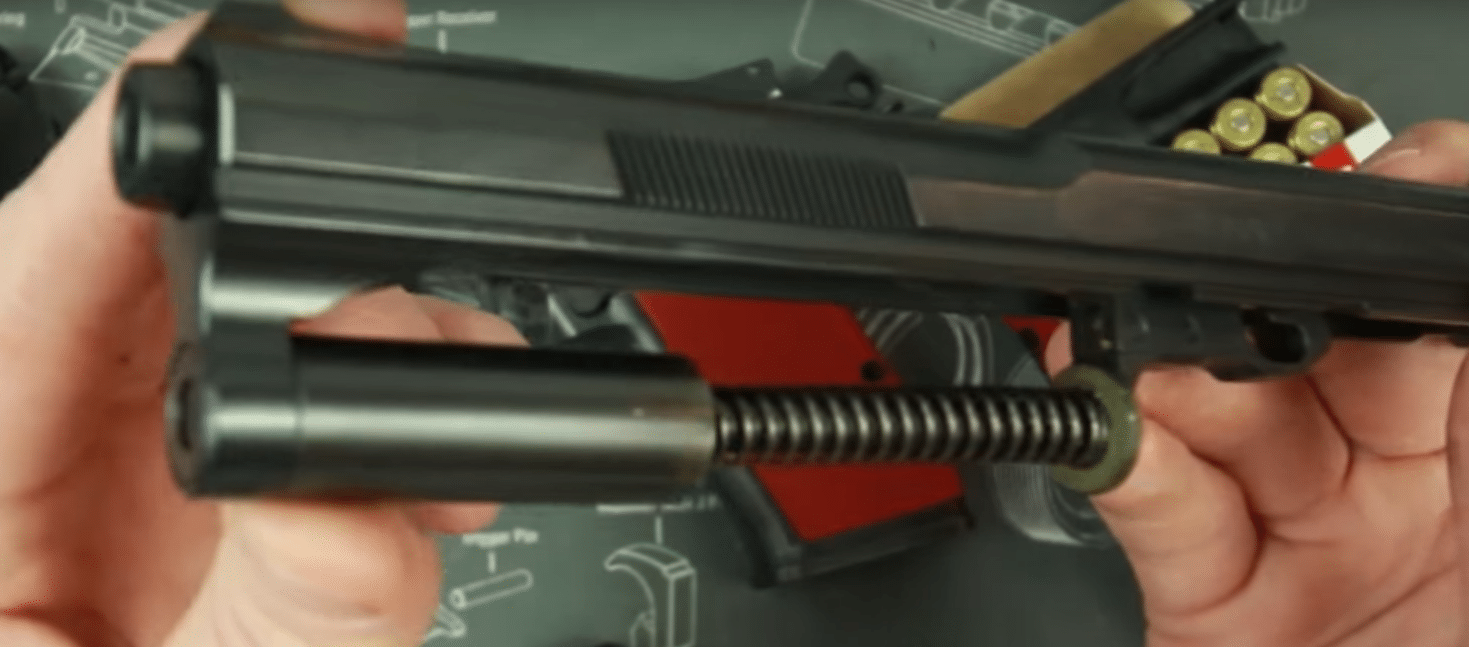
FK BRNO Field Pistol Barrel
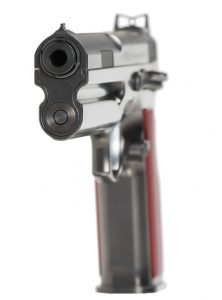
The slide has front and rear diagonal serrations, pretty standard in semi-auto handguns, but it also has its front part “melted” or shaved off to reduce unnecessary weight. A heavy slide on any semi-auto handgun will require a heavy-recoiling round to eject the empty brass and a heavy recoil spring to complete its cycle (and to reduce wear on the frame from the breech face being pummeled by the recoil).
Sights
Another feature of the handgun that makes it unique is it comes installed with a patented “Butterfly” rear sight that has a ghost ring. This works well for long range, take-your-time recreational shooting (and maybe long-range medium game hunting), guaranteed to shoot tight groups within a 3.9-sq.in. target at 100 meters.
But this special rear sight wouldn’t do so well in CQB or other personal and home defense scenarios where faster target acquisition is required. For those purposes, the standard Novak-style rear sight that also comes with the handgun is the better option and can be easily installed on the dovetail-cut slide’s rear. It can only be adjusted for windage.
The front sight has a red fiber optic insert and comes pre-adjusted out of the factory for elevation. Because of the almost 10-inch sight radius, when aligning the sights, the red dot gets really tiny while the ghost ring on the Butterfly rear sight becomes blurry, giving a clearer sight picture which results in a more accurate shot.
Being a single-action-only type pistol (pulling the trigger only releases the hammer), the FK Field Pistol’s frame has a slide stop lever and manual safety lever. Polymer handgun lovers will probably hate those controls, but all-steel 1911 or Browning Hi-Power purists will love them.
Also because of being single-action only, the trigger pull weight is around 4.5 lbs. and breaks smoothly. It has zero creep.
FK BRNO Field Pistol – Grip
In addition, the FK Field Pistol has a beavertail grip, a proven grip design that eliminates hammer bites when shooting single-action only pistols with an exposed hammer. And the hammer on the pistol looks like the typical combat-style hammer for modern 1911-style or Browning Hi-Power handguns.
The grip is only 1-inch wide, making this handgun surprisingly thin for what is supposedly a wide-body frame build, which is typical of all semi-auto handguns that accept staggered-column magazines (i.e. double stack magazines).
From the base of the inserted magazine to the top of the Butterfly sight, the handgun measures 5.6 inches in height. The height measures only 5.4 inches if the Butterfly sight is removed and the standard Novak-style rear sight is installed.
Speaking of magazines, a brand new FK Field Pistol comes with two in the box, each magazine can fit 16 7.5mm FK cartridge.
The FK Field Pistol’s frame dimensions make for a solid purchase on the grip, which shouldn’t come as a surprise considering the fine engineering and craftsmanship behind the handgun’s development and construction.
Grip designs come in anodized aluminum, wood, plastic and G10 — an extremely strong fiber glass material made of epoxy laminate. I think the wood grips are the best looking option for this handgun. There is nothing more aesthetically pleasing than the look of a polished blued handgun fitted with wood grips.
7.5mm FK vs. Other Handgun Calibers
Sure, the 7.5mm FK bullet has been proven to penetrate over 50 cm (19.68 inches) of ballistics gelatin with bone and denim simulants and four layers of denim.
But being the numbers guy that I am and with no other sources of comparison data available anywhere at the moment, I decided to crunch some numbers to get a better idea how the 7.5mm FK compares to other more common handgun calibers on the US market.
Here’s a table that has all the necessary data to compare the 7.5mm FK with 14 of the more powerful handgun cartridges commercially available. Seven of these are for semi-auto handguns and the remaining seven are for revolvers.
To make sense of all the data on the table, I created a few graphs, just the way I did it when I compared 52 of the most common US handgun cartridges in a recent article:
Velocity
The velocity chart shows that the 95-grain 7.5mm FK bullet (green bar) at 2,000 feet per second is around 24.37% faster than the fastest .44 Magnum load on the market which uses a 180-grain .429-inch bullet.
The 7.5mm FK bullet is also 25% faster than the hottest .44 Magnum load which uses a heavy 250-grain bullet that can be propelled from a 6-inch magnum revolver at speeds of around 1,550 feet per second.
What this means is the 7.5mm FK will have a significantly flatter trajectory compared to any .44 Magnum loads on the market today. It will be more accurate at longer distances.
The only cartridge that beats it in the velocity department is the .22 TCM, another fairly recent cartridge design that uses a lightweight 40-grain bullet measuring .224 inches in diameter that can fly out of a 5-inch-barrel 1911-style handgun at 2,777 feet per second. Whoever said the 7.5mm FK is the fastest semi-auto handgun cartridge in the world is dead wrong.
Muzzle Energy
As far as muzzle energy, the .44 Magnum in this boxing weight class is the undisputed champion.
Yes, they do move slower than the 7.5mm FK bullet, but these are wider and heavier bullets. The hottest .44 Magnum load with a 250-grain bullet moving at 1,550 feet per second has a muzzle energy of 1,333 ft.lbf, which means it’ll deliver around 58% more oomph than the 7.5mm FK when comparing point-blank shots.
Even the El Cheapo watered-down .44 Magnum load that uses a 180-grain bullet with velocities of up to 1,610 feet per second will have a muzzle energy of 1,036 ft.lbf when shot from a 6-inch barrel. This makes light .44 Magnum loads 22.75% more powerful than the 7.5mm FK, again when comparing point blank shots.
Price
Ammo is reportedly selling for $50 per box of 50 rounds. We found some at Palmetto State Armory.
| Product Name | Where to Buy | |
|---|---|---|
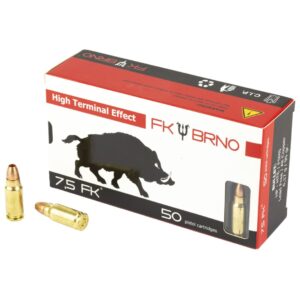 | 7.5mm FK Ammo | |
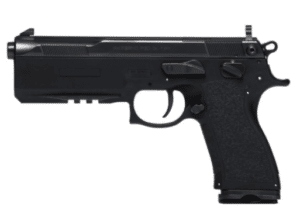 | FK BRNO Field Pistol |
7.5mm FK Ammo for Sale
All copper, monolithic nose discarding hollow point. The nose is designed to break off on impact, leaving a jagged 7mm meplat to create a large deep penetrating wound channel and a High Terminal Effect. Accurate and effective for defence and medium game hunting up to 200 lbs to 100 yards.
As the graph shows, the light .44 Magnum load having 22.75% more muzzle energy is 20% cheaper than the 7.5mm FK at just $0.80 per round. But it compares rather favorably with all the other handgun cartridges within its muzzle energy class.
And take note, the 7.5mm FK cartridge uses precision-machined solid copper bullets. This makes the chart skewed, because while all the other cartridges on the chart use jacketed hollow point bullets with a lead core (which are relatively cheaper), the 7.5mm FK only uses solid copper.
How much does the FK BRNO Field Pistol cost?
Now comes the bitter pill to swallow.
To get the exact price for the FK Field Pistol, I went to the manufacturer’s website and found two distributors in the US: Luxury Firearms, LLC in Oklahoma, and Bullseye Guns in Florida.
I sent an email to both companies. So far I have yet to get a reply from Bullseye Guns, but the CEO of Luxury Firearms, Tony Mussatto, replied to me promptly to set up a phone call with his assistant. A few days after, we talked over the phone about pricing and some of the company’s future plans for distributing the pistols and cartridges.
It was then I found out that the FK BRNO Field Pistol was selling for a jaw-dropping $7,500.
Since then I found variations on guns.com
FK BRNO Field Pistol
Even considering the uber-high costs of years of R&D to come up with a new design, setting up the required tools and machinery, manufacturing, the product’s value proposition, and even the novelty that comes with it and/or whatever else I might have overlooked, I wouldn’t personally buy this pistol — then again it would be because I’m a cheapskate.
Other Miscellaneous FK BRNO Field Pistol Info
While talking to Tony, I asked a few other questions which I know a lot of other handgun enthusiasts are asking:
Q: The online consensus among firearms enthusiasts is the FK Field Pistol is a fantastic piece of hardware, all things considered. However most people don’t think they’d want one because of the price. I read that article from icetraining.info which says, and I quote, “FK BRNO is very clear that they are not building a gun for the masses, nor are they open to outside theories in this area.” But the article was written February of this year. Are there really no plans to mass-produce these pistols in the foreseeable future?
A: No. There are only 1,001 of these handguns made for the US. After 1,001, we’ll go to a different model.
Q: Will that model also chamber the same 7.5mm FK rounds?
A: Yes, it will. It’ll be a combat version.
Q: Would that happen to be the shorter version with a 5-inch-barrel that I saw on the manufacturer’s website?
A: Yes.
Q: How much would that cost?
A: That’s too far out right now.
Q: I can’t help but compare the 7.5mm cartridge to another proprietary cartridge that came out fairly recently, the .22 TCM. Rock Island Armory now has rifles built to chamber the .22 TCM. I think the 30-caliber FK round is way up there on the kinetic energy scale. Do you know if FK has any plans of building rifles or carbines or any other types of firearm that chambers their cartridge as well?
A: Not at this time.
Q: Further on the cartridge, I noticed that all three load variants use solid copper. Does the company have plans to manufacture bullets with a lead core? Like a standard FMJ or a JHP with lead core? Because I think lead bullets being cheaper, it’ll encourage handloaders to buy the handgun and reload their own ammo.
A: No, not at this time.
Q: Is it a limitation of the pistol that it can only use solid copper bullets?
A: No comment on that one. I don’t know exactly.
Q: On a YouTube video uploaded by a user named TFB TV, he said they were unable to fit 16 rounds in either of the two magazines that came with his review sample. Could there be potential issues with the magazines or are they just doing things wrong?
A: The review sample’s magazine had extra strong springs. It won’t be an issue with commercial versions of the magazines. Those will use different springs and will fit the full capacity of 16 rounds.
Q: You said there are only 1,001 of the 6-inch FK Field Pistol made for the US. Will there also be a limited number of the 5-inch-barrel combat models you mentioned? And when will those be released?
A: I can’t say anything on that right now.
FK BRNO Field Pistol – Conclusion
To say the FK Field Pistol is a masterpiece is an understatement.
Sure, full-power .44 Magnum loads are still more powerful than the cartridge it uses. And lighter .44 Magnum loads are also cheaper round-per-round.
But consider these six reasons why you should get an FK Field Pistol if your budget allows it:
- Ammo Capacity:The .44 Magnum revolver typically only holds six rounds versus the FK Field Pistol’s magazine that holds 16. You can shoot more before you have to reload.
- Speed of reloading:Reloading a six shooter with another six rounds is too slow compared to reloading the FK Field Pistol with another 16 rounds. You can shoot more bullets faster with the semi-auto.
- Ease of concealed carrying:The .44 Magnum revolver by virtue of having a cylinder is bulky and not ideal for concealed carry. The FK Field Pistol being a semi-auto and having a narrower frame with no cylinder will be easier to carry concealed.
- Ease of holster carrying:
The typical 6-inch-barrel .44 Magnum revolver has an overall length of around 12-inches, while the FK Field Pistol’s overall length is only 10 inches. Holster carry wouldn’t be too much of a problem with the FK Field Pistol (it even comes with a holster out of the box).
- Accuracy:Most big-bore revolvers only come with standard adjustable iron front and rear sights. The FK Field Pistol comes with two types of interchangeable rear sights, one is for long range shooting and the other is for personal defense.
- Intended Purpose:Typically, .44 Magnum revolvers are only used for hunting medium to large game (and maybe for home defense or as a truck gun). The FK Field Pistol can be used for a lot of other things: competition, hunting medium game, home defense and concealed carrying for CQB scenarios.
If I had several thousand to spare, I wouldn’t hesitate to get me one of these fine pistols. Then again that’d be a big “IF”.
I think FK BRNO should be keen on establishing these new handguns as the next semi-auto norm. It’s always possible to find ways of driving production expenses down. If they’ll sell the combat version of these 7.5mm FK pistols cheaper, I’m all in.




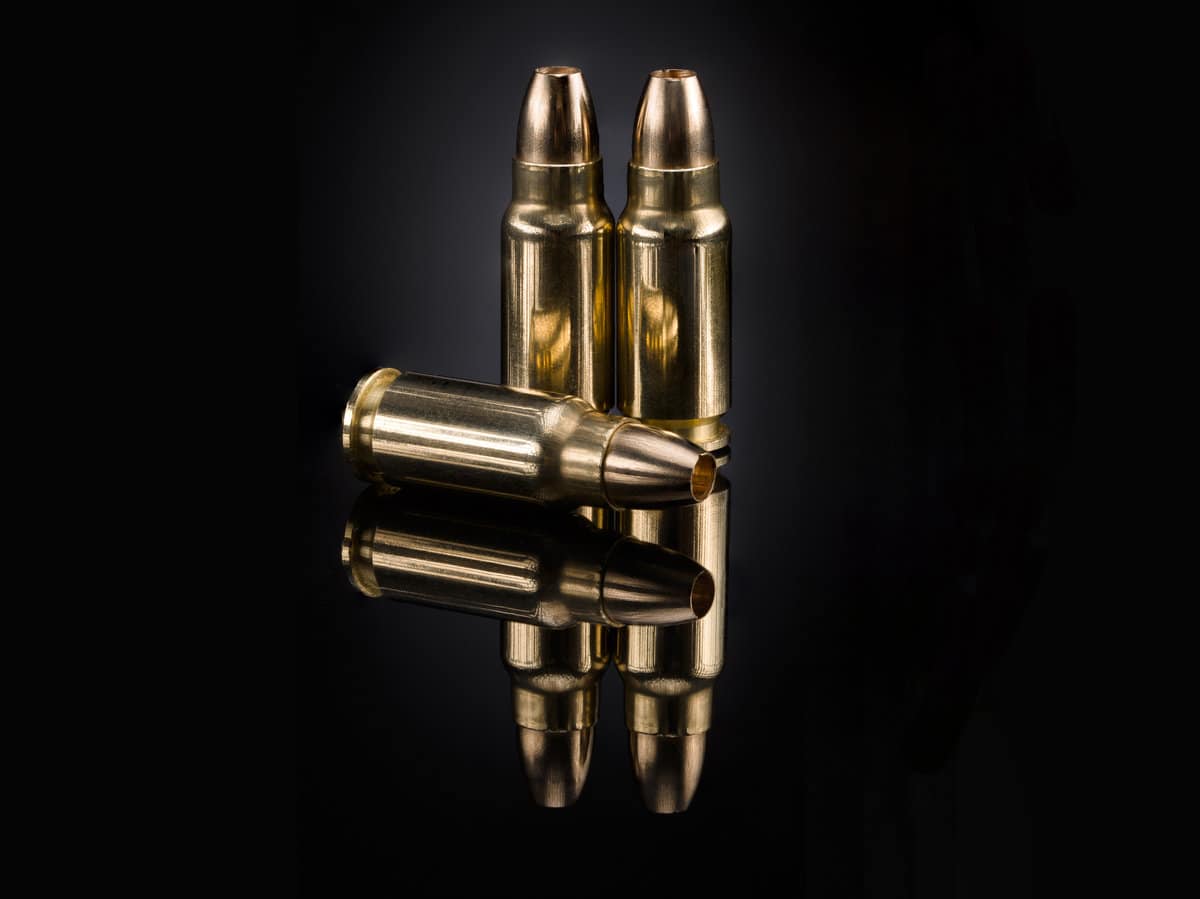

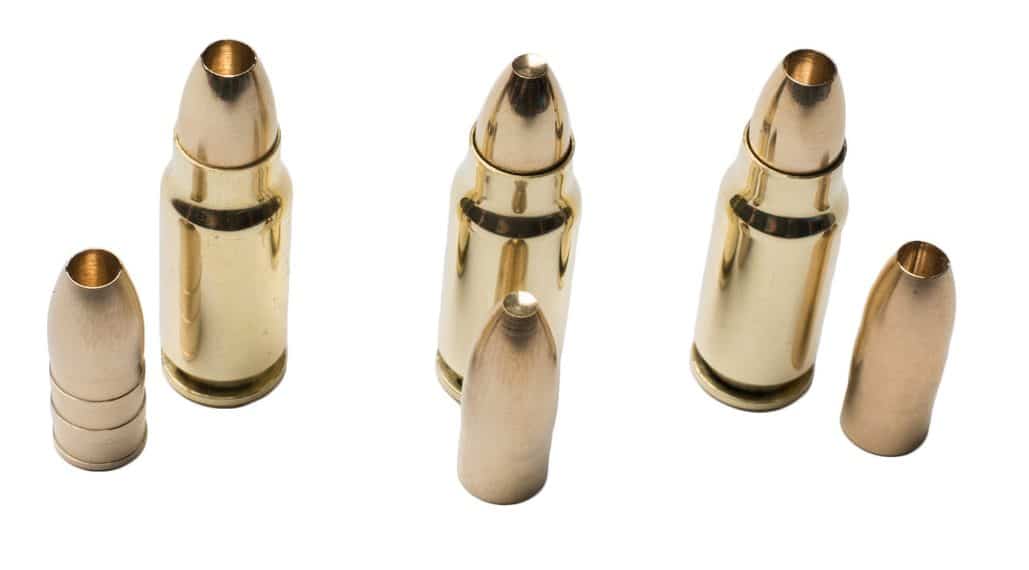
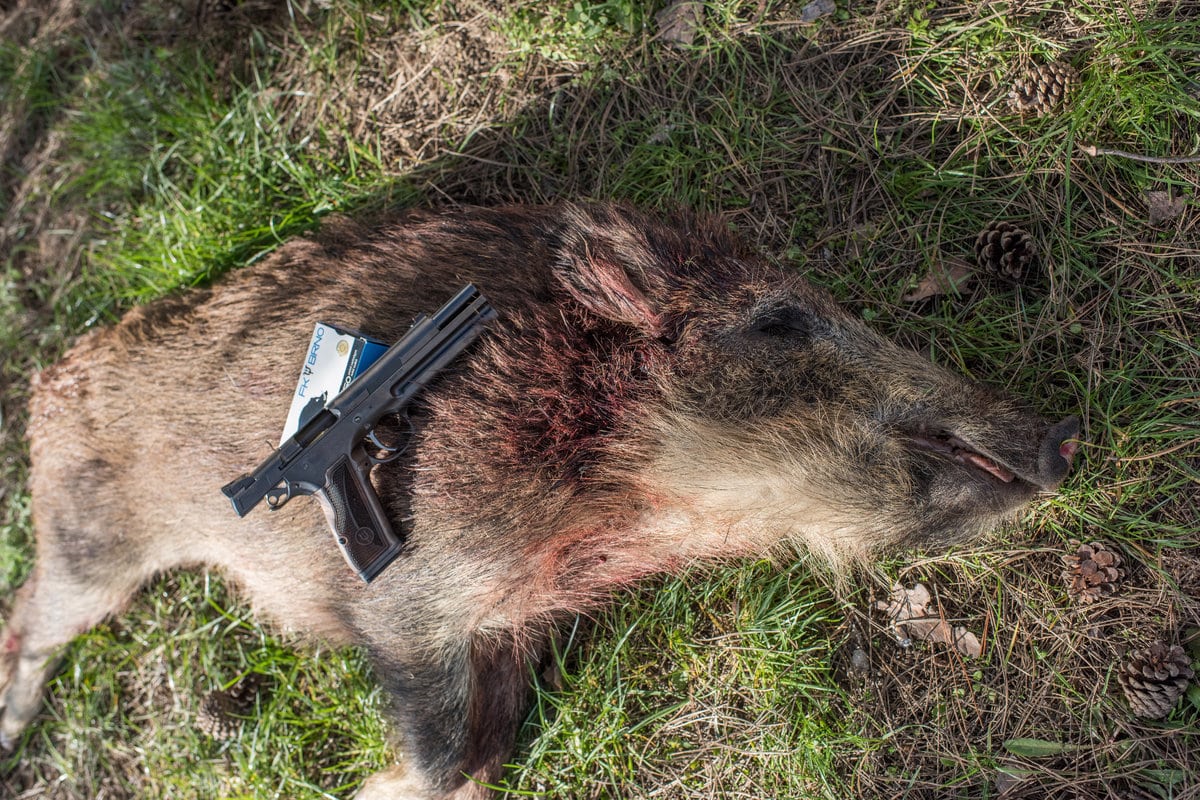
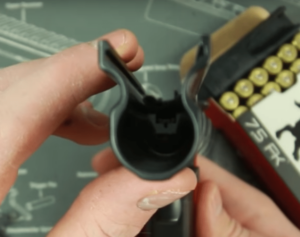
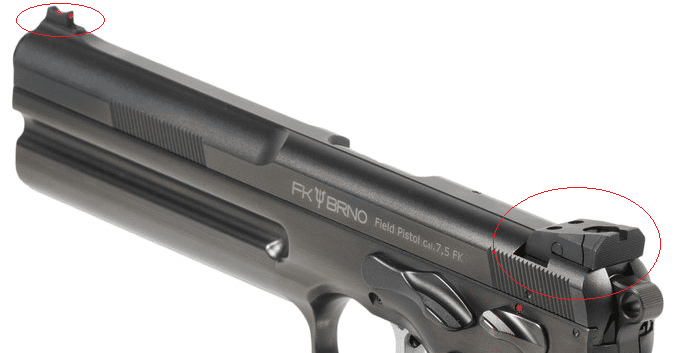

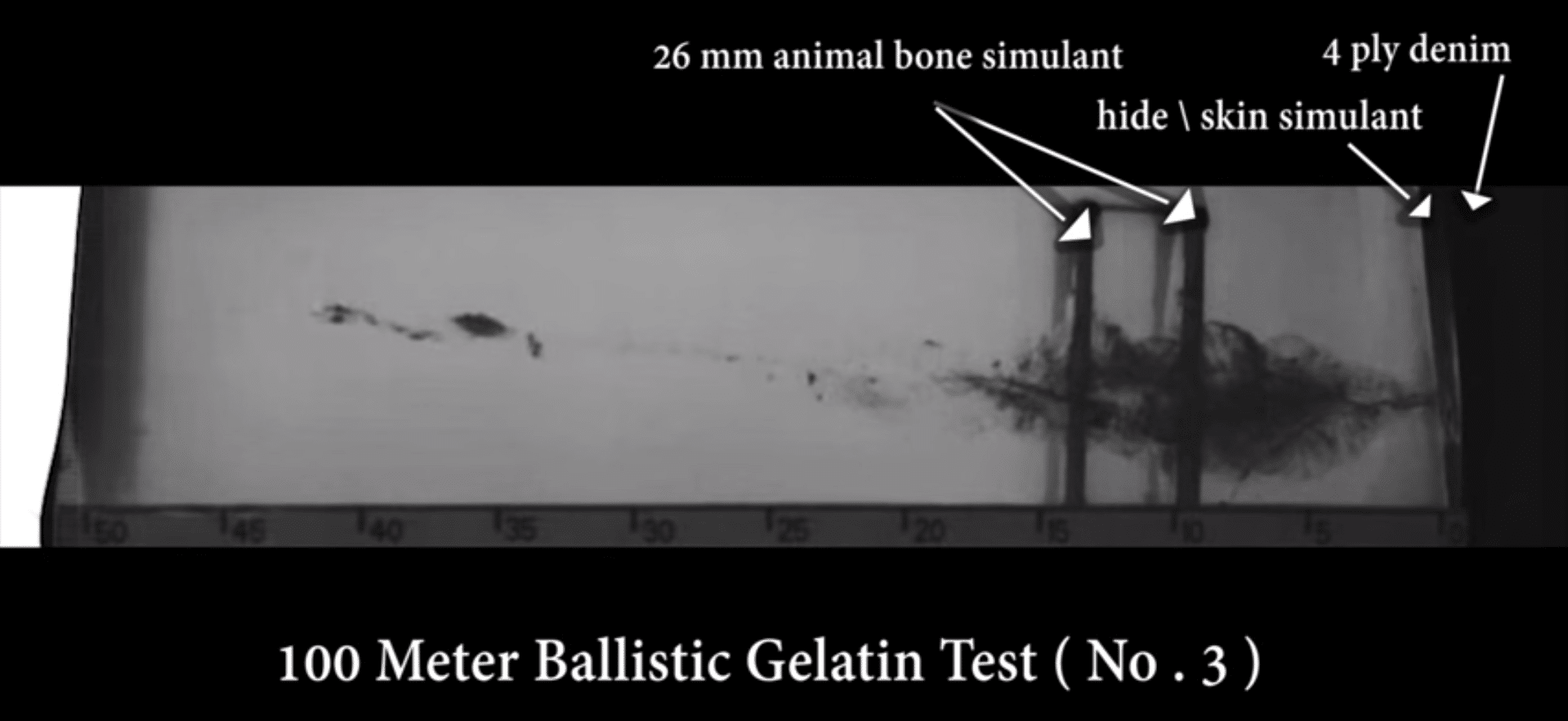
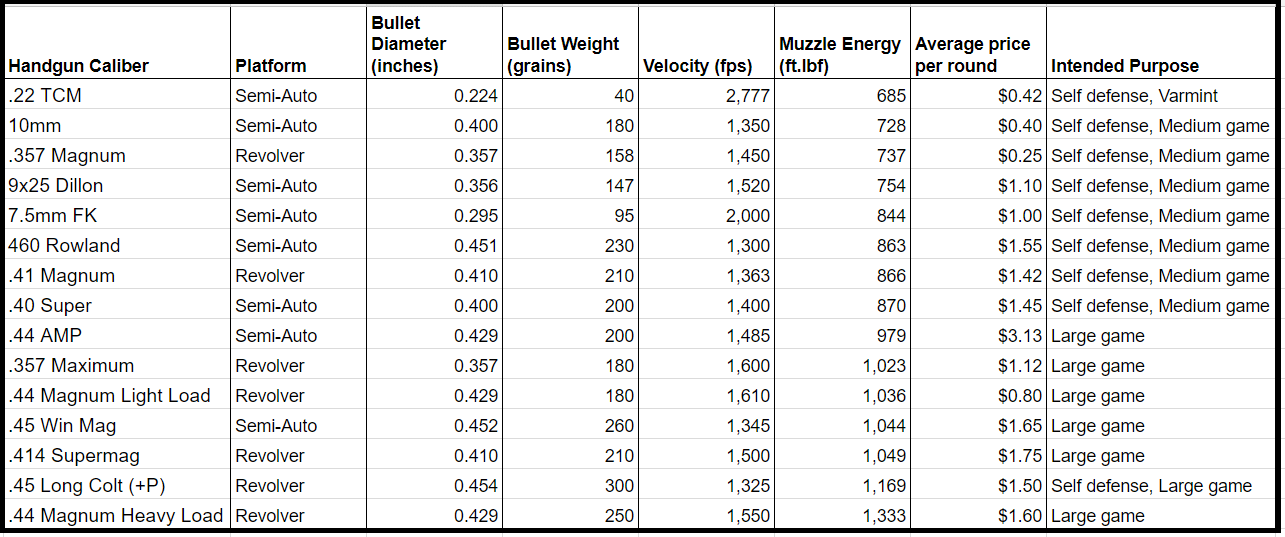
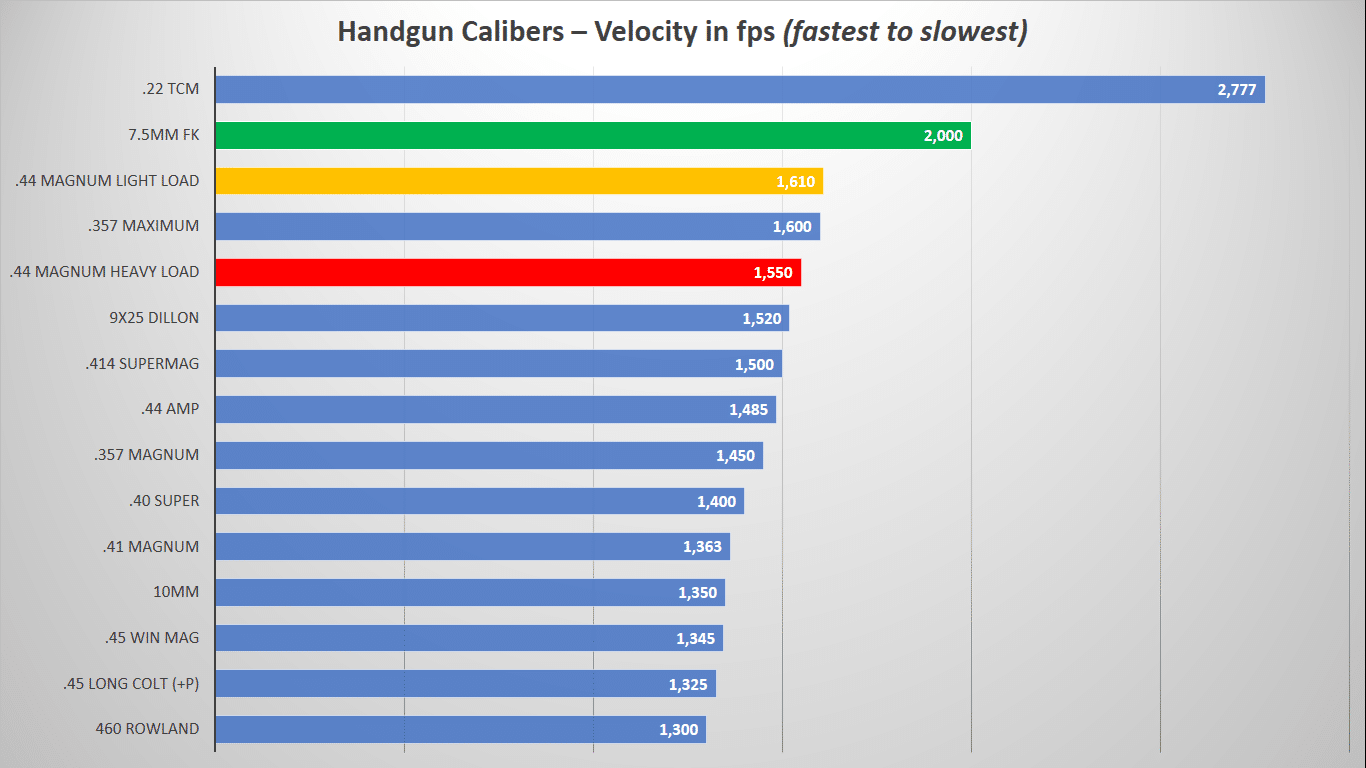
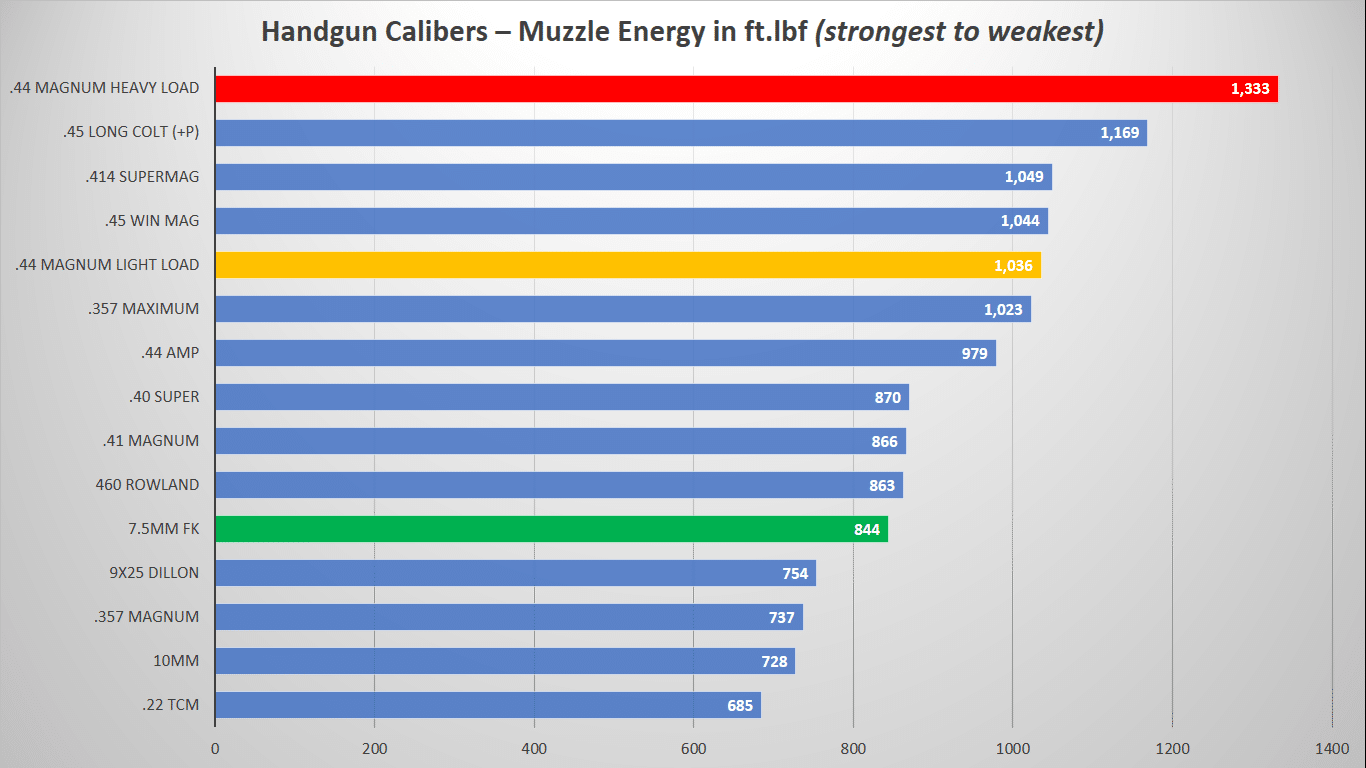
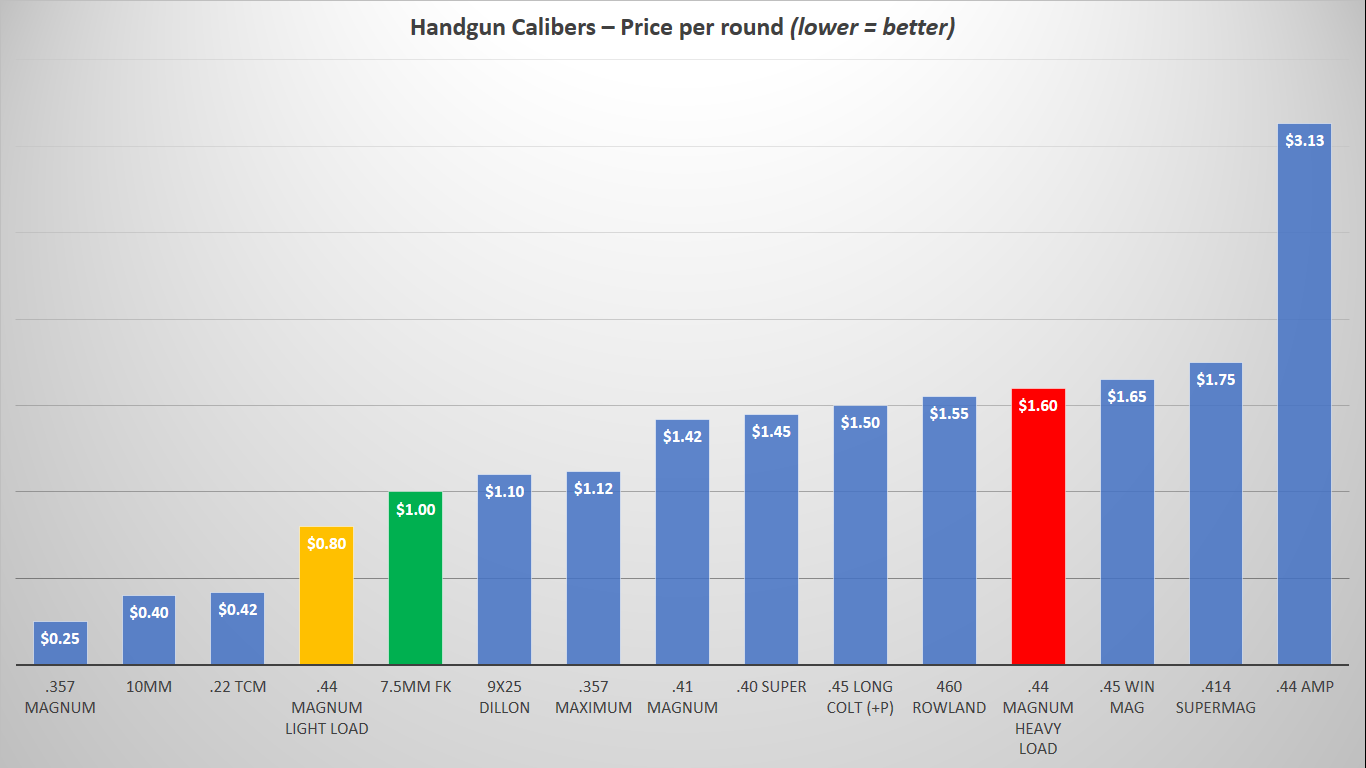
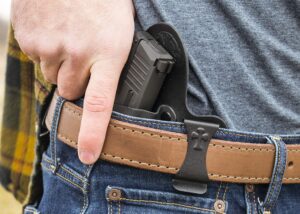
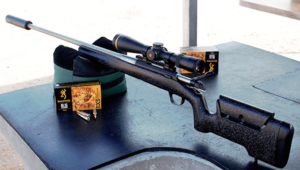
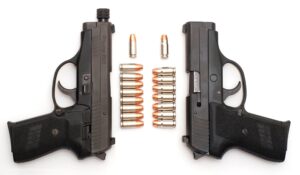
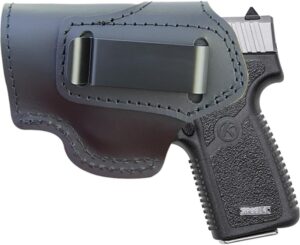


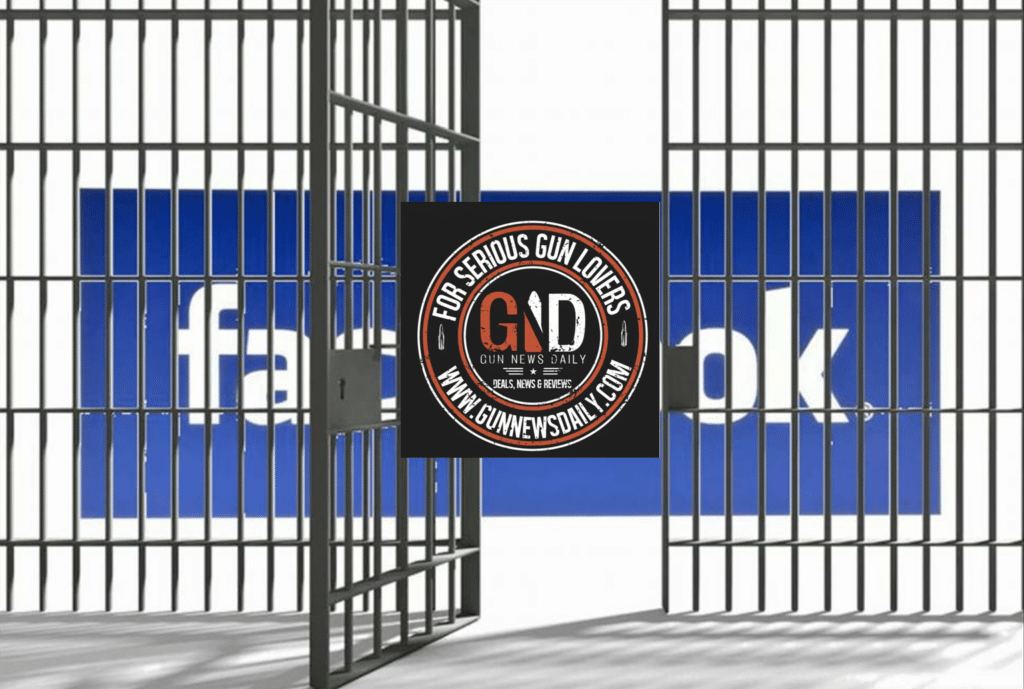
5 Responses
Dear Sir,
The data for the 22 TCM is for a 22inch rifle not a handgun. Most barley make 2000 while the 7.5 will deliver 2000fps even out of a 5″ barrel.
When comparing revolver barrel length to pistol , one needs to deduct the chamber length , so a 6″ pistol in 7.5 is equal to a 4.5″ revolver barrel.
lastly we feel that the 44 magnum numbers presented are not practical to shoot in any meaningful way. One cannot realistically exceed 1400fps in that caliber out of 5 inch revolver .
This product was made for professionals in combat , for long range stand off and assault beyond 100 meters. At that distance the revolvers don’t shine so much.
Lastly , please feel free to contact us directly and you will always be welcome to come visit us and shoot this pistols or others and maybe find out firsthand the answer to some of your questions.
@fk brno engineering team,
Thanks for taking the time to read through my article and posting a comment. Allow me to answer a few arguments you made in it.
–“The data for the 22 TCM is for a 22inch rifle not a handgun.”
It looks like there was indeed an error on my part, thanks for pointing it out. But wait…
–“Most barley make 2000 while the 7.5 will deliver 2000fps even out of a 5″ barrel.”
After doing a quick research, I found that the .22 TCM is still the faster round — average velocity out of a 5-inch barrel is ~2,100 feet per second, give or take a few. This means that despite the initial error, the 7.5 FK round is still not the fastest handgun cartridge in the world — whoever said it was, is wrong.
–“When comparing revolver barrel length to pistol , one needs to deduct the chamber length , so a 6″ pistol in 7.5 is equal to a 4.5″ revolver barrel.”
Not sure where this comes from. As far as barrel lengths, it is true that semi-auto and revolver barrels cannot be compared apples-to-apples because of the way each platforms’ chambers are designed. But for the sake of simplicity, I don’t think subtracting an arbitrary number from either the revolver’s or the semi-autos should be done at all when comparing, for two reasons:
1. Typical .44 magnum chamber length is much, much longer than the 7.5FK’s chamber length, but that length isn’t really utilized by the .44 Magnum’s bullet a lot because its cartridge OAL is also much, much longer. I have no time right now to look up the exact numbers but I imagine that if we look at where either cartridge headspaces and we try to get a ratio between the length of the cartridge’s rear that sits in the chamber (i.e. from the neck down) vs. that length of the cartridge’s front (i.e. from the neck up), and we compare these ratios, the 7.5 mm with its shorter OAL will end up having a better underutilized chamber space vs. useful chamber space ratio, thereby negating any imaginable advantage a .44 Magnum revolver’s longer chamber might offer.
2. Revolvers have that gap between the barrel and the cylinder. This is not present in semi-auto pistols. This also effectively negates whatever unfair velocity advantage a revolver’s barrel might have over a semi-auto’s barrel when comparing both guns with the same barrel lengths, as ascertained by a certain gentleman who compared the bullet velocity differences between a 6-inch Colt Python and a 5-inch Coonan pistol.
https://www.gunsamerica.com/digest/357-shoot-off-coonan-vs-python/
This means even with a shorter overall chamber + barrel length, a semi-auto handgun will always offer better ballistics than a revolver with the same barrel length. So really, there’s no point in comparing your gun’s 6-inch barrel to a .44 Magnum revolver with a 4.5 inch barrel. I’d rather keep it simple.
–“lastly we feel that the 44 magnum numbers presented are not practical to shoot in any meaningful way. ”
Meaningful is a subjective word here. If we’re talking big game hunting or bear defense, a hot .44 Magnum loaded with a Keith-style hardcast or a heavy swaged bullet should outclass any 7.5FK bullet at distances of up to 50 meters. For any target farther than those distances, I imagine the 7.5FK will be better, if only because of two factors: better bullet sectional density, and better trajectory over longer distances.
–“This product was made for professionals in combat , for long range stand off and assault beyond 100 meters. At that distance the revolvers don’t shine so much.”
I can’t agree more. In fact, If you really take the time to understand what I said in the conclusion, I can’t emphasize enough the fact that I think the 7.5FK shooting platform (handgun+ammo) is a great option, regardless of distance or the user’s intended purpose. The only thing holding me from recommending it is the price.
On a final note, I’m sure anyone with money to burn and intent on purchasing the fine weapon you engineered will still purchase it for whatever reason, regardless of whether they read this article or not. As far as I’m concerned, my arguments in this article are fair and founded in reality. The majority of firearms enthusiasts in the US just don’t have $7,500 to spend on a handgun, no matter how good it is at anything. You can look at forums and Facebook pages everywhere, and the consensus among people talking about this weapon is that’s just too much money for whatever value the gun offers. But you guys already knew that when you decided to only do a limited manufacturing run of these.
All that aside, I want to say I enjoyed writing and doing research on this article and having known everything I know now about this gun, I’ll always hold it in high regard even with its unrealistic price.
I know this is a fairly old article now, but I just wanted to say that FK BRNO really hit it out of the park with their latest PSD pistol. They seemed to really listen to the consumers who were reluctant to invest in the 7.5fk environment and developed an outstanding weapon in the PSD as a result. They were able to bring the price down to a reasonable $1650, plus they were able to offer it with the ability to swap calibers to 10mm Auto or 9mm to offer the buyer more affordable ammo options for training and reserve the more expensive 7.5x27mm ammo for carry and field use. They also wisely designed the PSD to accommodate micro red dot optics without having to sacrifice having iron sights mounted to the slide, and they designed their red dot mount with the ability to accept both the Trijicon RMR and Delta Point Pro footprints and any optics using either footprint. I would have absolutely loved to have been able to own the original Field Pistol, but sadly I just can’t afford it at that price point. But I’m now a proud owner of their PSD pistol and I couldn’t be happier with it. They were able to make a more versatile pistol at a price point that more people can justify without sacrificing quality, fit, or finish from the Field Pistol aside from moving from a metal frame to a polymer frame, and even the polymer frame is made to a much higher standard than most polymer pistols like GLOCK. I own an H&K Mark 23 and the PSD compares very favorably to the H&K in most ways, and surpasses it in others. And the PSD is a much more practical weapon for personal defense and concealed carry than the Field Pistol, being more compact and lighter weight.
Seriously… little fast bullets are for people that don’t understand ballistics is a gimmick round. If that is what really worked, everybody would be bear hunting with .22-250s…
Just some simple chrono data from my guns on what matters when hitting a target.
.357 Sig 147 gr… 190 Power Factor
7.5 BRNO 95 gr… 190 Power Factor
.40 S&W 180 gr… 200 Power Factor
.327 Fed Mag 130 gr 217 Power Factor
9x25mm Dillon 125 gr… 220 Power Factor
.45 ACP +P 230 gr… 220 Power Factor
10mm UW 220 gr… 275 Power Factor
.41 Mag 265 gr… 400 Power Factor
.44 Mag 340 gr… 500 Power Factor
And don’t try to talk “Energy”. I don’t care if you put it in BTU’s, Ergs, Therms, Ft-lbs, etc. I don’t care about the total potential heat energy, but the actual effect on target. I have no idea how people came to think of KE as something significant to ballistics. Same bullet weight, fine, but then you are just back to which is fastest.
Perfect example right here. Everybody would think the .338 RUM would kick the crap out of the .458 SOCOM and 12 GA Slug looking at the ‘KE’. But if I was popping off at a charging bear, give me the SOCOM or 12. Harder hitting and deeper penetration as the Power Factor/KOV shows.
12 Ga. Slug 440 gr KE 2,500 ft-lbs, PF- 705, KOV- 73
.458 SOCOM 405 gr JFP, KE- 2,378 ft-lbs, PF- 658, KOV- 43.1
.338 RUM 225 gr. KE- 4,800 ft-lbs, PF- 698, KOV- 34.
Well if it’s so great mass produce them or forget look whare glock is today bye given a nice price and quality on top